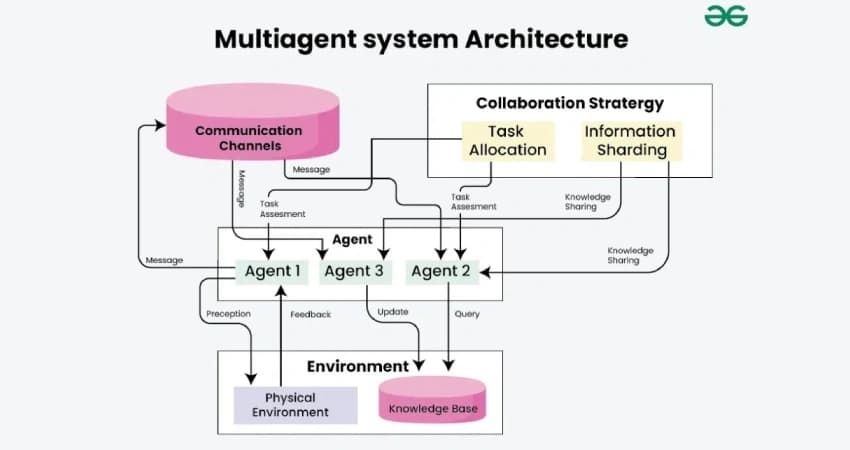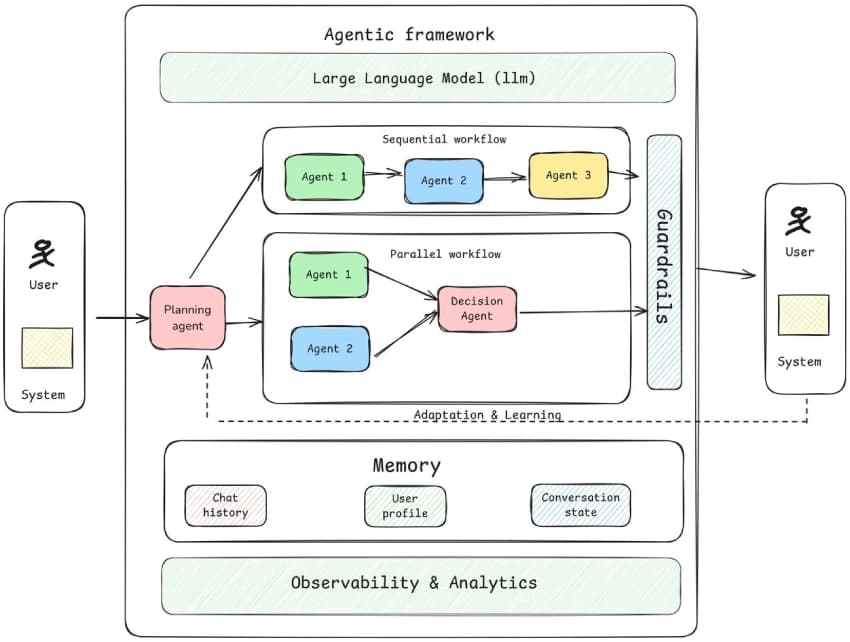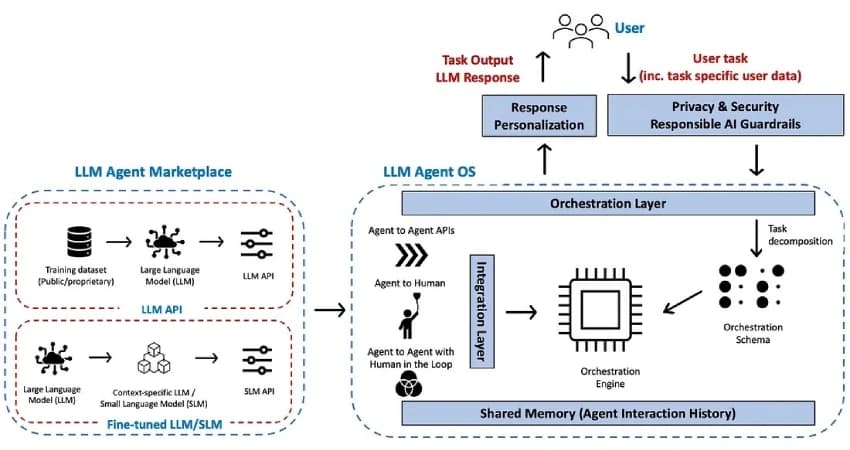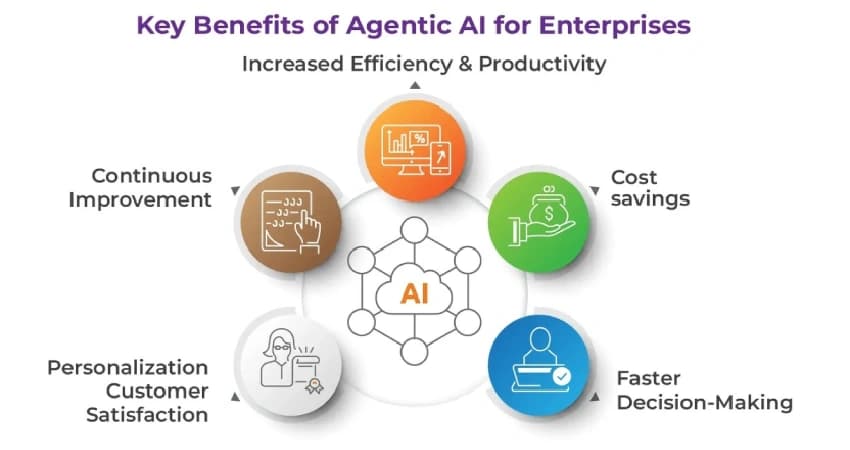This piece explores the true meaning of "agentic" AI, the inner workings of autonomous systems, their real-world applications in various industries, and key considerations for businesses looking to adopt this next-generation AI technology.
Defining Agentic AI and Its Core Capabilities

Image Source: Medium
Agentic AI marks a transformation from systems that just analyze or generate content to those that act independently. These artificial intelligence systems can make decisions and handle complex tasks with minimal human oversight.
- What is agentic AI? Definition and context
Agentic AI uses machine learning models that mirror human decision-making to solve problems immediately. The word "agentic" points to these models' agency—their power to act independently and purposefully to reach defined goals. These systems maintain long-term objectives, handle multistep problem-solving tasks, and track progress over time.
Agentic AI builds on generative AI techniques and uses large language models (LLMs) to work in dynamic environments. Generative models create content based on learned patterns, but agentic AI takes this further by using these outputs to reach specific goals. To name just one example, see how a generative AI model creates text or code, while an agentic system uses that content to complete complex tasks on its own by calling external tools.
The system architecture uses AI agents—autonomous entities that handle specific subtasks needed to reach an overall goal. These agents work together through AI orchestration, which allows sophisticated problem-solving. Gartner predicts that by 2028, all but one of three enterprise software solutions will include agentic AI, making up to 15% of day-to-day decisions autonomous.
- How agentic AI is different from traditional AI systems
Traditional AI systems work within set limits and need constant human input. They follow fixed rules and react only to user inputs. These systems struggle to apply training data to new situations.
Agentic AI shows these qualities:
- Proactive behavior - It goes beyond task execution by understanding context, assessing options, and adapting its behavior to reach specific goals. It starts actions based on its understanding of objectives rather than waiting for commands.
- Self-improvement capability - Agentic systems learn from experiences, use feedback, and adjust their behavior.
- Cross-system operation - AI agents search the web, call APIs, query databases, and use this information to decide.
This difference shows a transformation from traditional automation, which works well within programmed limits but can't adapt to changes. Traditional AI automates routine tasks, while agentic AI takes part in problem-solving and decision-making.
- Key traits: autonomy, reasoning, and adaptability
Agentic AI systems have several unique features:
- These systems show autonomous reasoning—knowing how to take business objectives and decide how to achieve them by analyzing limits and assessing trade-offs. A four-step approach aids this process: see, reason, act, and learn. The system collects information, analyzes data to grasp the situation, creates and follows a plan, then learns from results.
- Agentic AI shows immediate adaptability. It adjusts behavior based on changing conditions instead of following fixed scripts. The system keeps context through various memory types—short-term for current interactions, long-term for historical data, episodic for past interactions, and consensus memory for information shared among agents.
- These systems excel at multistep task execution and manage entire workflows rather than single actions. They spot problems, gather inputs from other systems, choose solutions, and complete tasks.
- Agentic AI demonstrates shared orchestration. Multiple specialized agents contribute to common goals without direct human coordination. This makes it possible to handle complex, unpredictable environments that would otherwise need significant human input.
Understanding the Role of AI Agents in Agentic Systems

Image Source: Sify
AI agents are the basic building blocks of agentic systems. These digital workers act as independent entities that can sense their surroundings, process data, and take action on their own. They make up the core of what we call agentic AI.
- What is an AI agent? Definition and types
An AI agent works as a self-governing computational entity. It makes choices and handles tasks based on what it senses in its environment through sensors and preset goals. Unlike basic programs, these agents work independently and adjust to new situations to get results.
AI agents fall into several categories, each more advanced than the last:
- Simple reflex agents react directly to what they sense around them. They follow preset rules without thinking about past events or what might happen next. A thermostat that starts heating when it's cold shows this behavior.
- Model-based reflex agents keep an internal picture of their world. This helps them work even when they can't see everything by remembering previous interactions.
- Goal-based agents go beyond just reacting. They take an active role in solving problems by weighing different actions against their goals.
- Utility-based agents take this a step further. They look at multiple factors like power use or costs to pick actions that give the best results.
- Learning agents get better through reinforcement learning and machine learning. They adapt their methods and come up with new approaches as time passes.
- Reactive vs proactive agents in dynamic environments
Reactive and proactive agents show a key difference in how capable they are. Reactive agents only respond to what's happening right now. They don't look at past experiences or future goals. They work like a chess AI that only looks at the current board setup.
Proactive agents look ahead by studying past data and spotting patterns. They plan actions to reach long-term goals. Take a proactive AI running a supply chain - it might spot upcoming demand spikes from yearly trends and adjust stock levels early, even if current numbers don't show a need.
These agents make decisions differently. Reactive agents use basic if-then logic without memory or learning abilities. This makes them quick for simple tasks but they struggle with uncertainty. Proactive agents use neural networks or reinforcement learning to test possible outcomes. They keep getting better through feedback.
- How multiple agents cooperate in agentic AI
Multi-agent systems (MAS) show what happens when specialized agents work as a team. They can do more together than any single agent could alone. These systems let independent agents reach shared goals through organized teamwork.
Agents in these systems talk to each other using set rules. They share what they know about their environment, make decisions together, and coordinate their actions. This teamwork lets them specialize, back each other up, and solve problems in ways single agents can't match.
A network of healthcare agents shows this in action. They can track vital signs, spot problems, suggest treatments, and handle patient records while following regulations. Their teamwork ensures everything runs smoothly, accurately, and reliably throughout the process.
Technical Architecture Behind Agentic AI Frameworks

Image Source: Swapan Rajdev
AI systems have sophisticated technical architecture under the hood that powers their autonomous capabilities. A look at these core components shows how these systems work their magic.
- Large language models (LLMs) for reasoning and planning
LLMs serve as the brain of agentic AI and act as primary reasoning engines. These neural networks excel at understanding, summarizing, and making decisions. They face three big limitations that need extra engineering: they run slower than regular software, they can't remember things between chats, and their knowledge has fixed cutoff dates.
AI systems don't just send user prompts straight to LLMs. The LLM mostly processes carefully built context from chat history, documents, and external data. This approach gives the model exactly what it needs to create useful responses.
- Memory systems: short-term vs long-term context
Memory systems help AI agents remember and recall information. Short-term memory holds data briefly—usually seconds to minutes—and can only store 5-9 pieces of information. It works like a quick notepad that helps chatbots keep track of conversations and self-driving cars process sensor data.
Long-term memory stores information for much longer periods and has much more space. Agents use it to build knowledge, learn from past events, and make better choices. Most systems use databases, knowledge graphs, or vector embeddings. Apps like recommendation engines and personal assistants rely on long-term memory to track user's priorities and past actions.
- Tool integration and orchestration layers
Tool calling lets agents do more than just think—they can use external APIs, get real-time data, and work with other systems.
The coordination layer helps multiple specialized agents work together toward common goals. Teams of focused agents work better than one do-it-all AI. Most integration strategies use open protocols like the Model Context Protocol (MCP) and framework tools to build things quickly.
- Planning frameworks: ReAct, AutoGPT, CrewAI
New frameworks help structure agentic AI systems better. ReAct makes agents think through problems step by step, gather facts, and take smart actions. This clear approach cuts down mistakes by avoiding quick jumps to conclusions.
AutoGPT handles complex tasks on its own through self-guided prompting. It uses GPT-powered reasoning to handle multi-step tasks. CrewAI offers an open-source framework to coordinate teams of specialized agents. Each agent gets a specific role in a shared "crew." This setup mirrors real teams and helps divide work efficiently.
Real-World Applications of Agentic AI Across Industries

Image Source: ML Conference
AI agents are reshaping major industries. They have evolved from theoretical concepts into practical tools that deliver measurable business value through autonomous, intelligent systems. These real-life implementations show how AI agents solve complex operational challenges with minimal human oversight.
- Customer service: proactive issue resolution
AI agents have transformed customer support by anticipating needs instead of just reacting to requests. Unlike traditional chatbots that follow predefined scripts, these agents handle natural, dynamic conversations while they solve issues independently. The systems detect problems before customers report them. They use sentiment analysis to spot frustration and take action by issuing support tickets or processing refunds. The numbers tell an impressive story - by 2029, AI agents will solve 80% of common customer service issues without human help, which cuts operational costs by 30%.
- IT support: automated ticket triage and resolution
Intelligent agents now manage IT operations, detect anomalies, and optimize system performance. This leads to less downtime and fewer operational risks. The systems keep an eye on network health, predict possible failures, and fix issues before users notice problems. Major incident resolution times have dropped by 15-25 minutes. AI agents can check multiple systems at once while human engineers work on strategic improvements.
- HR automation: onboarding and benefits personalization
AI agents create better employee experiences by handling administrative tasks on their own. These agents set up individual-specific task lists during onboarding. They send automated reminders and adjust workflows based on role, region, and contract type. The agents help existing employees with common questions about benefits, leave policies, and career growth. IBM's AskHR system now handles over 80 common HR requests automatically. This lets HR professionals focus on strategic initiatives rather than routine tasks.
- Cybersecurity: threat detection and adaptive response
AI systems improve security through constant, adaptive threat detection. The agents watch networks, spot new attack patterns, and deploy countermeasures to contain threats quickly. They analyze transactions as they happen to find unusual patterns that might signal fraud. One system cut down the time needed to check software vulnerabilities from hours to seconds. It does this by evaluating environments and ranking findings for quick, smart action.
- Data engineering: self-healing pipelines and schema updates
AI agents have changed how teams build and maintain data pipelines. These agents work throughout the data engineering lifecycle to build, monitor, optimize, and maintain pipelines. They find and catalog data sources, design the best transformation strategies, run quality checks, and optimize performance without human input. The agents spot schema changes, update metadata, and trigger actions in tools like Slack or Jira. This creates systems that fix themselves and cut down manual maintenance work by 64%.
Want to learn how AI agents can reshape your organization's operations? today.
Benefits and Challenges of Adopting Agentic AI

Image Source: AutomationEdge
Organizations face amazing opportunities and tough challenges as they work with agentic AI's two-sided nature.
- Increased automation with reduced manual oversight
Agentic AI makes efficiency better than traditional automation by removing delays between tasks and running parallel processes. These systems coordinate multiple steps at once, unlike sequential workflows. This cuts down cycle time and makes systems more responsive. The benefits include:
- Operational costs reduction through decreased labor requirements
- Boosted productivity as employees focus on strategic work rather than routine tasks
- Improved accuracy and consistency in task execution
- Better scalability without needing proportional resource increases.
A Harvard Business School study shows generative AI can boost highly skilled employees' performance by up to 40%. Companies using these systems have seen over 15% reduction in compliance costs and more than 46% revenue increases.
- Real-time responsiveness and decision-making
Agentic AI makes rapid decisions by processing massive data volumes in seconds—way beyond what humans can do. These systems watch data sources non-stop and respond to changing conditions without human input.
AI agents adjust to new information, like shipping delays or changing demand, and optimize delivery schedules automatically. This non-stop optimization creates smarter business operations. Systems can change process flows instantly, reorder tasks, or spot problems before they turn into bigger issues.
- Trust, explainability, and safety concerns
Agentic AI brings critical trust barriers despite its benefits. The "black box" problem leads the list—AI agents often use complex reasoning chains humans find hard to follow. Companies might need to work backward to figure out what went wrong when issues arise, which creates accountability problems.
Security weak spots pose another major worry. AI agents need access to multiple systems and sensitive data, making them attractive targets for cyberattacks. Bad actors could mess with AI outputs or sneak in without permission if security measures aren't strong enough.
Bias remains a constant challenge. AI agents could multiply biases thousands of times daily without oversight if training data isn't clean. Forrester's research points out that "A human making biased decisions might affect dozens of customers per day. An AI agent making biased decisions could affect thousands per hour".
- Monitoring and debugging autonomous workflows
Good monitoring helps implement agentic AI responsibly. Companies should track AI performance using metrics like accuracy, response time, and resolution rates. Strong governance frameworks should include:
- Live tracking of agent activities and decisions
- Automated alert systems for suspicious behavior
- Regular audits of agent performance and outputs
This monitoring should act as safety rails against risks without stopping agent autonomy. Systems might drift from their original purpose without proper governance as they learn and grow.
Ready to guide your organization through agentic AI implementation? to create a strategy that fits your company's unique needs.
Conclusion
Agentic AI leads the rise of artificial intelligence, marking a crucial move from reactive systems to truly autonomous digital workers. This piece explores how these advanced systems fundamentally differ from traditional AI through their independent reasoning, decision-making, and adaptability. Without doubt, agentic AI's core strength comes from knowing how to maintain long-term objectives while tackling complex, multi-step problems without constant human supervision.
Large language models combined with sophisticated memory systems and tool integration frameworks form the technical backbone. This setup makes AI agents notice their environment, reason through challenges, take actions, and learn from outcomes. On top of that, frameworks like ReAct, AutoGPT, and CrewAI offer structured ways to apply these autonomous systems.
Real-life applications in customer service, IT support, HR, cybersecurity, and data engineering show agentic AI's practical value. Companies using these technologies see faster incident resolution, lower operational costs, and better scalability. The numbers tell the story—82% of companies plan to implement AI agents within three years. Gartner predicts one-third of enterprise software will include agentic capabilities by 2028.
These impressive benefits come with challenges. The "black box" problem creates trust barriers when AI's reasoning becomes sort of hard to get one's arms around. Security vulnerabilities and potential bias amplification need careful governance and monitoring systems. Organizations should balance autonomy with appropriate oversight to tap into the full potential while reducing risks.
This move toward agentic AI shows how artificial intelligence exceeds simple automation to become a collaborative partner in business operations. These systems continue to develop and promise to transform organizations by handling complex workflows autonomously. Human talent focuses on strategic initiatives. Success belongs to businesses that thoughtfully integrate these autonomous capabilities while building robust governance frameworks for responsible deployment.
Key Takeaways
Agentic AI represents a revolutionary shift from reactive systems to autonomous digital workers that can reason, plan, and execute complex tasks independently. Here are the essential insights every business leader should understand:
- Agentic AI operates autonomously - Unlike traditional AI that follows scripts, these systems make independent decisions, adapt to changing conditions, and pursue long-term objectives without constant human supervision.
- Multi-agent collaboration amplifies capabilities - Specialized AI agents work together in coordinated teams, each handling specific tasks while contributing to shared outcomes through structured communication protocols.
- Real-world applications deliver measurable ROI - Companies implementing agentic AI see 15-25 minute reductions in incident resolution times, 30% cost savings in customer service, and 40% performance boosts for skilled employees.
- Technical architecture combines LLMs with memory systems - The foundation includes large language models for reasoning, short and long-term memory for context retention, and tool integration layers for external system access.
- Trust and governance remain critical challenges - The "black box" problem creates accountability issues, while security vulnerabilities and potential bias amplification require robust monitoring frameworks and governance structures.
With 82% of companies planning AI agent adoption within three years, organizations must balance the transformative potential of autonomous AI with careful implementation strategies that prioritize transparency, security, and responsible deployment.






